Go here to Read this Fast! Koala Coin rises alongside Bitcoin Cash and Injective Protocol
Originally appeared here:
Koala Coin rises alongside Bitcoin Cash and Injective Protocol
Go here to Read this Fast! Koala Coin rises alongside Bitcoin Cash and Injective Protocol
Originally appeared here:
Koala Coin rises alongside Bitcoin Cash and Injective Protocol
Ethereum saw a huge drop in Open Interest in April following the rejection at $3.7k
The on-chain metrics were still healthy, hinting at the possibility of an uptrend
Ethereum [ETH] was tradi
The post Is Ethereum set for a comeback after $3.7k rejection? Metrics suggest… appeared first on AMBCrypto.
Go here to Read this Fast! Is Ethereum set for a comeback after $3.7k rejection? Metrics suggest…
Originally appeared here:
Is Ethereum set for a comeback after $3.7k rejection? Metrics suggest…
Originally appeared here:
Apple close to landing streaming rights for big soccer tourney, report says
Go here to Read this Fast! DeeStream presale draws Tether, Tezos investors amid BTC halving buzz
Originally appeared here:
DeeStream presale draws Tether, Tezos investors amid BTC halving buzz
Go here to Read this Fast! Experts eye Milei Moneda presale amid anticipated SOL, BNB surge
Originally appeared here:
Experts eye Milei Moneda presale amid anticipated SOL, BNB surge
Decreasing volatility suggests that WIF might keep trading between $2.31 and $4.
Many traders have open short positions, predicting a price decrease.
Solana-based memecoin dogwifhat [WIF] mi
The post Why WIF’s $5 goal may face a setback in April appeared first on AMBCrypto.
Shiba Inu team raised $12 million to create new layer 3 blockchain.
Despite developments overall activity on the network declined.
The Shiba Inu [SHIB] team has secured $12 million to advanc
The post Shiba Inu’s $12M bet: Here’s what it means for SHIB holders like you appeared first on AMBCrypto.
In the bustling world of cryptocurrencies, Shiba Inu (SHIB) and its burgeoning counterpart, Shiba Budz (BUDZ), are creating waves among investors. Particularly, those looking to transform modest inves
The post SHIB Mania with Shiba Inu & Shiba Budz, how to turn $250 to $2,500 in SHIB? appeared first on AMBCrypto.



Reinforcement learning is a domain in machine learning that introduces the concept of an agent who must learn optimal strategies in complex environments. The agent learns from its actions that result in rewards given the environment’s state. Reinforcement learning is a difficult topic and differs significantly from other areas of machine learning. That is why it should only be used when a given problem cannot be solved otherwise.
The incredible flexibility of reinforcement learning is that the same algorithms can be used to make the agent adapt to completely different, unknown, and complex conditions.
Note. To fully understand the ideas included in this article, it is highly recommended to be familiar with the main concepts of reinforcement learning introduced in the first part of this article series.
Reinforcement Learning, Part 1: Introduction and Main Concepts
In Part 1, we have introduced the main concepts of reinforcement learning: the framework, policies and value functions. The Bellman equation that recursively establishes the relationship of value functions is the backbone of modern algorithms. We will understand its power in this article by learning how it can be used to find optimal policies.
This article is based on Chapter 4 of the book “Reinforcement Learning” written by Richard S. Sutton and Andrew G. Barto. I highly appreciate the efforts of the authors who contributed to the publication of this book.
Let us imagine that we perfectly know the environment’s dynamics that contains |S| states. Action transition probablities are given by a policy π. Given that, we can solve the Bellman equation for the V-function for this environment that will, in fact, represent a system of linear equations with |S| variables (in case of the Q-function there will be |S| x |A| equations).
The solution to that system of equations corresponds to v-values for every state (or q-values for every pair (state, pair)).
Let us have a look at a simple example of an environment with 5 states where T is a terminal state. Numbers in blue represent transition probabilities while number in red represent rewards received by the agent. We will also assume that the same action chosen by the agent in the state A (represented by the horizontal arrow with probability p = 0.6) leads to either C or D with different probabilities (p = 0.8 and p = 0.2).
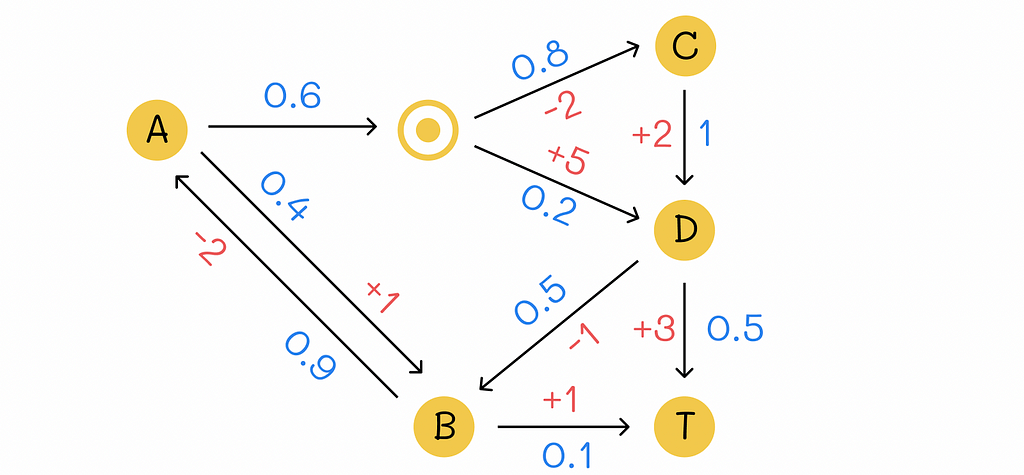
Since the environment contains |S| = 5 states, to find all v-values, we will have to solve a system of equations consisting of 5 Bellman equations:

Since T is a terminal state, its v-value is always 0, so technically we only have to solve 4 equations.

Solving the analogous system for the Q-function would be harder because we would need to solve an equation for every pair (state, action).
Solving a linear system of equations in a straightforward manner, as it was shown in the example above, is a possible way to get real v-values. However, given the cubic algorithm complexity O(n³), where n = |S|, it is not optimal, especially when the number of states |S| is large. Instead, we can apply an iterative policy evaluation algorithm:
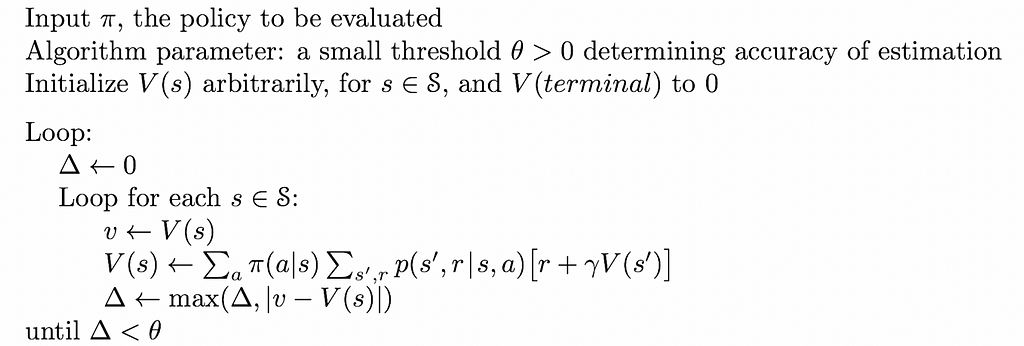
If the number of states |S| if finite, then it is possible to prove mathematically that iterative estimations obtained by the policy evaluation algorithm under a given policy π ultimately converge to real v-values!
A single update of the v-value of a state s ∈ S is called an expected update. The logic behind this name is that the update procedure considers rewards of all possible successive states of s, not just a single one.
A whole iteration of updates for all states is called a sweep.
Note. The analogous iterative algorithm can be applied to the calculation of Q-functions as well.
To realize how amazing this algorithm is, let us highlight it once again:
Policy evaluation allows iteratively finding the V-function under a given policy π.
The update equation in the policy evaluation algorithm can be implemented in two ways:
In practice, overwriting v-values is a preferable way to perform updates because the new information is used as soon as it becomes available for other updates, in comparison to the two array method. As a consequence, v-values tend to converge faster.
The algorithm does not impose rules on the order of variables that should be updated during every iteration, however the order can have a large influence on the convergence rate.
Description
To further understand how the policy evaluation algorithm works in practice, let us have a look at the example 4.1 from the Sutton’s and Barto’s book. We are given an environment in the form of the 4 x 4 grid where at every step the agent equiprobably (p = 0.25) makes a single step in one of the four directions (up, right, down, left).
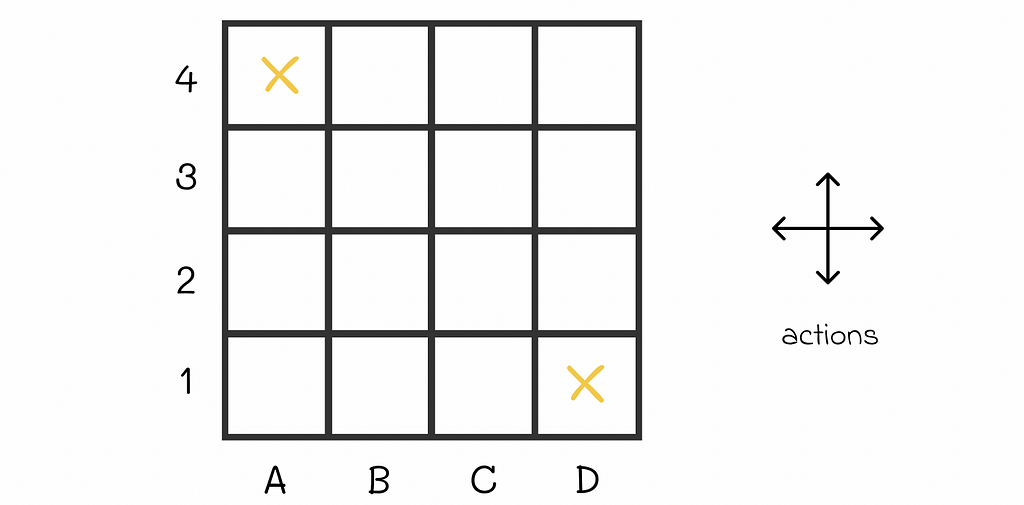
If an agent is located at the edge of the maze and chooses to go into the direction of a wall around the maze, then its position stays the same. For example, if the agent is located at D3 and chooses to go to the right, then it will stay at D3 at the next state.
Every move to any cell results in R = -1 reward except for two terminal states located at A4 and D1 whose rewards are R = 0. The ultimate goal is to calculate V-function for the given equiprobable policy.
Algorithm
Let us initialize all V-values to 0. Then we will run several iterations of the policy evaluation algorithm:
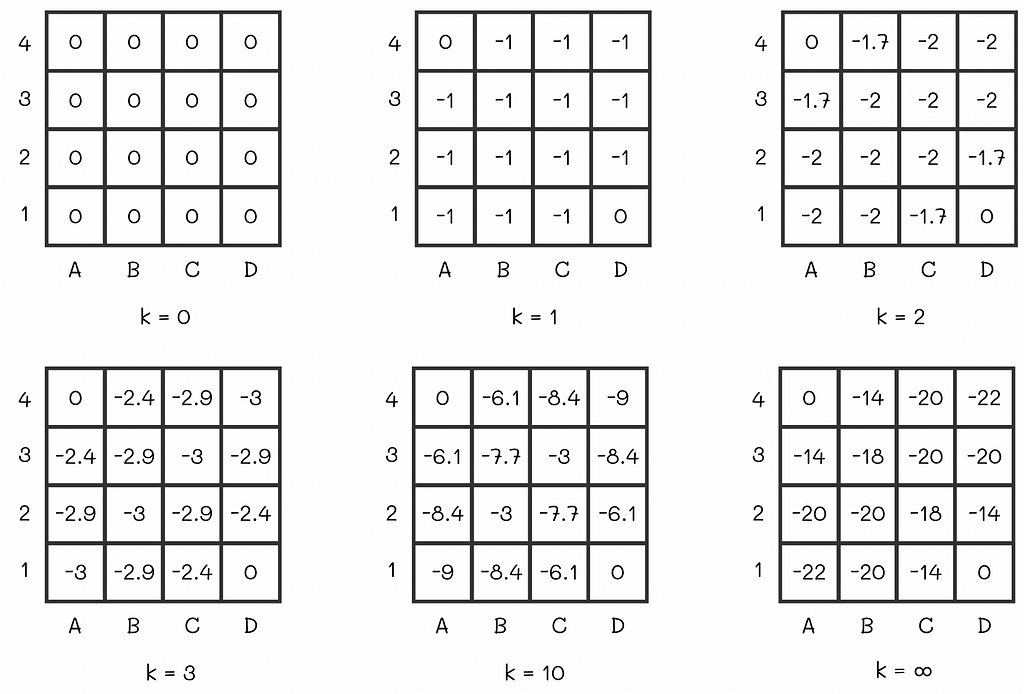
At some point, there will be no changes between v-values on consecutive iterations. That means that the algorithm has converged to the real V-values. For the maze, the V-function under the equiprobable policy is shown at the right of the last diagram row.
Interpretation
Let us say an agent acting according to the random policy starts from the cell C2 whose expected reward is -18. By the V-function definition, -18 is the total cumulative reward the agent receives by the end of the episode. Since every move in the maze adds -1 to the reward, we can interpret the v-value of 18 as the expected number of steps the agent will have to make until it gets to the terminal state.
At first sight, it might sound surprising but V- and Q- functions can be used to find optimal policies. To understand this, let us refer to the maze example where we have calculated the V-function for a starting random policy.
For instance, let us take the cell B3. Given our random policy, the agent can go in 4 directions with equal probabilities from that state. The possible expected rewards it can receive are -14, -20, -20 and -14. Let us suppose that we had an option to modify the policy for that state. To maximize the expected reward, would not it be logical to always go next to either A3 or B4 from B3, i.e. in the cell with the maximum expected reward in the neighbourhood (-14 in our case)?
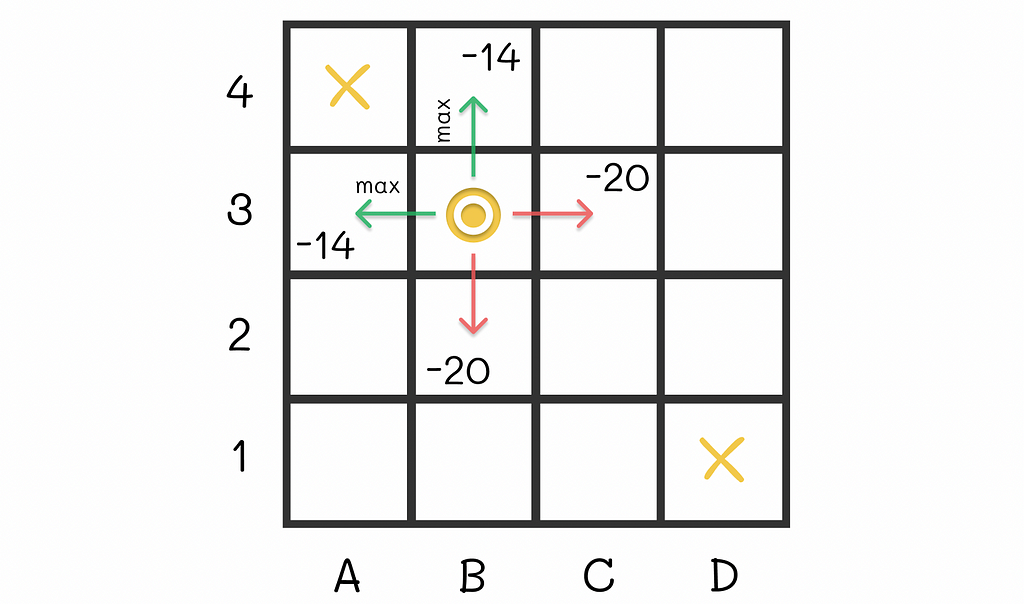
This idea makes sense because being located at A3 or B4 gives the agent a possibility to finish the maze in just one step. As a result, we can include that transition rule for B3 to derive a new policy. Nevertheless, is it always optimal to make such transitions to maximize the expected reward?
Indeed, transitioning greedily to the state with an action whose combination of expected reward is maximal among other possible next states, leads to a better policy.
To continue our example, let us perform the same procedure for all maze states:
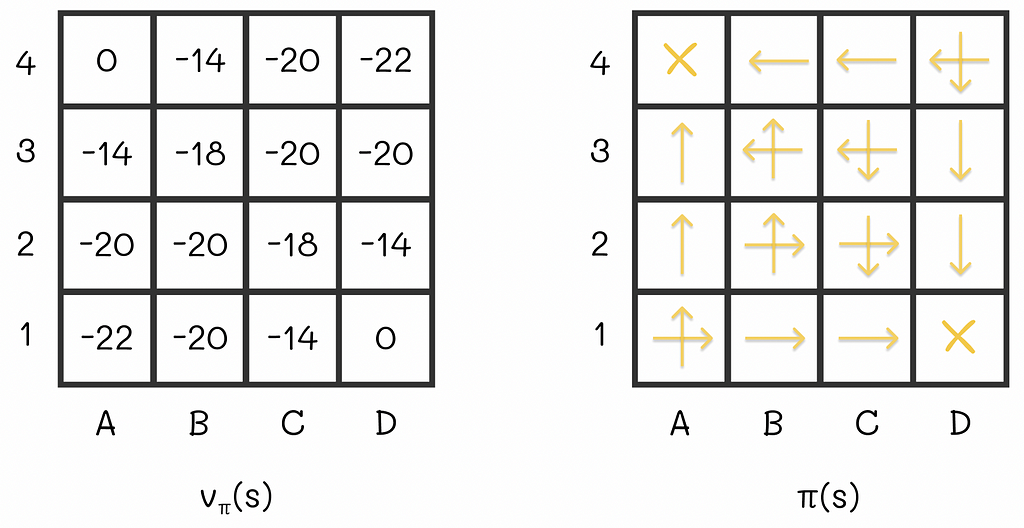
As a consequence, we have derived a new policy that is better than the old one. By the way, our findings can be generalized for other problems as well by the policy improvement theorem which plays a crucial role in reinforcement learning.
Formulation
The formulation from the Sutton’s and Barto’s book concisely describes the theorem:
Let π and π’ be any pair of deterministic policies such that, for all s ∈ S,

Then the policy π’ must be as good as, or better than, π. That is, it must obtain greater or equal expected return from all states s ∈ S:

Logic
To understand the theorem’s formulation, let us assume that we have access to the V- and Q-functions of a given environment evaluated under a policy π. For that environment, we will create another policy π’. This policy will be absolutely the same as π with the only difference that for every state it will choose actions that result in either the same or greater rewards. Then the theorem guarantees that the V-function under policy π’ will be better than the one for the policy π.
With the policy improvement theorem, we can always derive better policies by greedily choosing actions of the current policy that lead to maximum rewards for every state.
Given any starting policy π, we can compute its V-function. This V-function can be used to improve the policy to π’. With this policy π’, we can calculate its V’-function. This procedure can be repeated multiple times to iteratively produce better policies and value functions.
In the limit, for a finite number of states, this algorithm, called policy iteration, converges to the optimal policy and the optimal value function.

If we applied the policy iteration algorithm to the maze example, then the optimal V-function and policy would look like this:
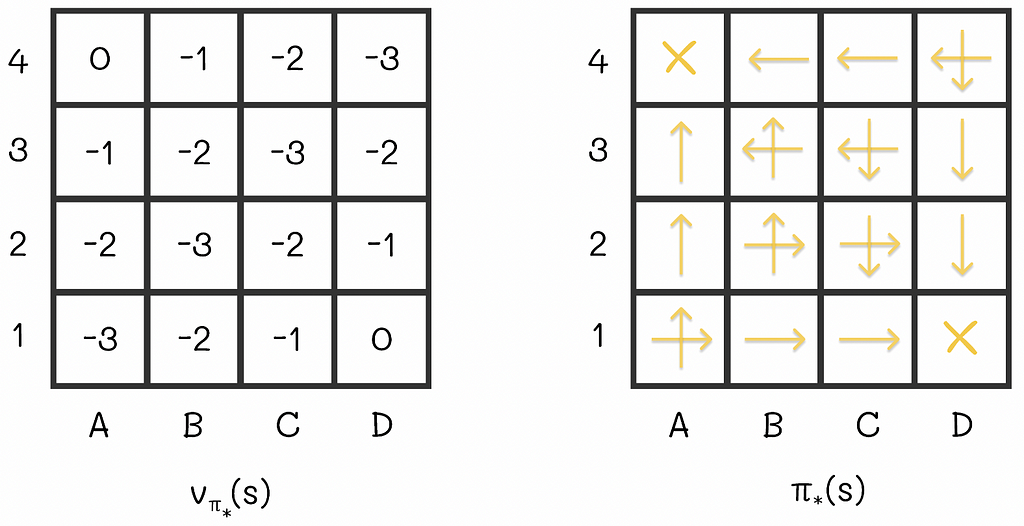
In these settings, with the obtained optimal V-function, we can easily estimate the number of steps required to get to the terminal state, according to the optimal strategy.
What is so interesting about this example is the fact that we would only need two policy iterations to obtain these values from scratch (we can notice that the optimal policy from the image is exactly the same as it was before when we had greedily updated it to the respective V-function). In some situations, the policy iteration algorithm requires only few iterations to converge.
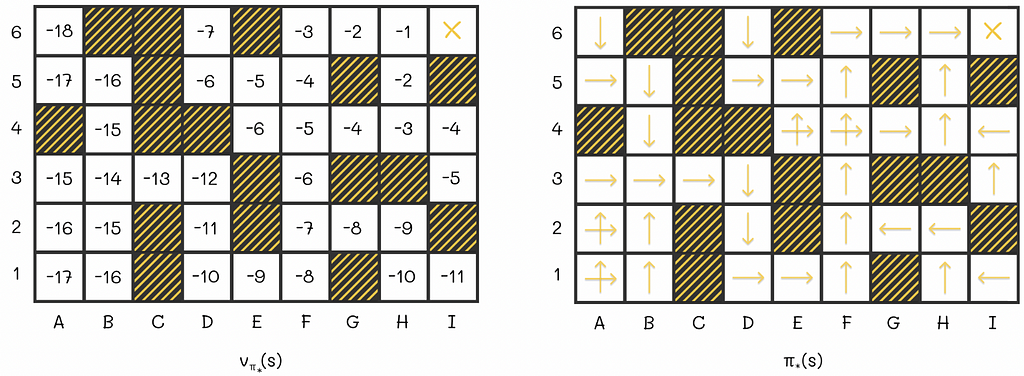
Though the original policy iteration algorithm can be used to find optimal policies, it can be slow, mainly because of multiple sweeps performed during policy evaluation steps. Moreover, the full convergence process to the exact V-function might require a lot sweeps.
In addition, sometimes it is not necessary to get exact v-values to yield a better policy. The previous example demonstrates it perfectly: instead of performing multiple sweeps, we could have done only k = 3 sweeps and then built a policy based on the obtained approximation of the V-function. This policy would have been exactly the same as the one we have computed after V-function convergence.
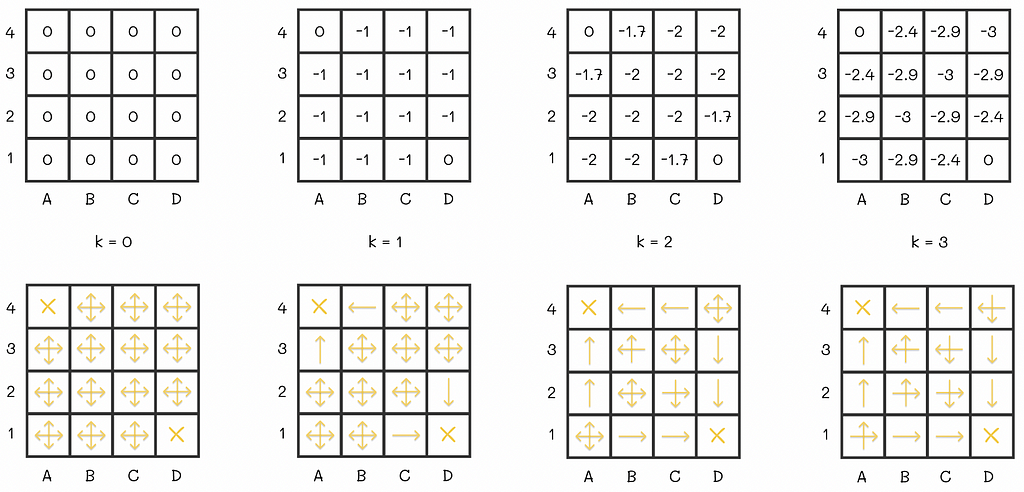
In general, is it possible to stop the policy evaluation algorithm at some point? It turns out that yes! Furthermore, only a single sweep can be performed during every policy evaluation step and the result will still converge to the optimal policy. The described algorithm is called value iteration.
We are not going to study the proof of this algorithm. Nevertheless, we can notice that policy evaluation and policy improvement are two very similar processes to each other: both of them use the Bellman equation except for the fact that policy improvement takes the max operation to yield a better action.
By iteratively performing a single sweep of policy evaluation and a single sweep of policy improvement, we can converge faster to the optimum. In reality, we can stop the algorithm once the difference between successive V-functions becomes insignificant.
In some situations, performing just a single sweep during every step of value iteration can be problematic, especially when the number of states |S| is large. To overcome this, asynchronous versions of the algorithm can be used: instead of systematically performing updates of all states during the whole sweep, only a subset of state values is updated in-place in whatever order. Moreover, some states can be updated multiple times before other states are updated.
However, at some point, all of the states will have to be updated, to make it possible for the algorithm to converge. According to the theory, all of the states must be updated in total an infinite number of times to achieve convergence but in practice this aspect is usually omitted since we are not always interested in getting 100% optimal policy.
There exist different implementations of asynchronous value iteration. In real problems, they make it possible to efficiently trade off between the algorithm’s speed and accuracy.
One of the the simplest asynchronous versions is to update only a single state during the policy evaluation.
We have looked at the policy iteration algorithm. Its idea can be used to refer to a broader term in reinforcement learning called generalized policy iteration (GPI).
The GPI consists of finding the optimal policy through independent alternation between policy evaluation and policy improvement processes.
Almost all of the reinforcement learning algorithms can be referred to as GPI.
Sutton and Barto provide a simplified geometric figure that intuitively explains how GPI works. Let us imagine a 2D plane where every point represents a combination of a value function and a policy. Then we will draw two lines:
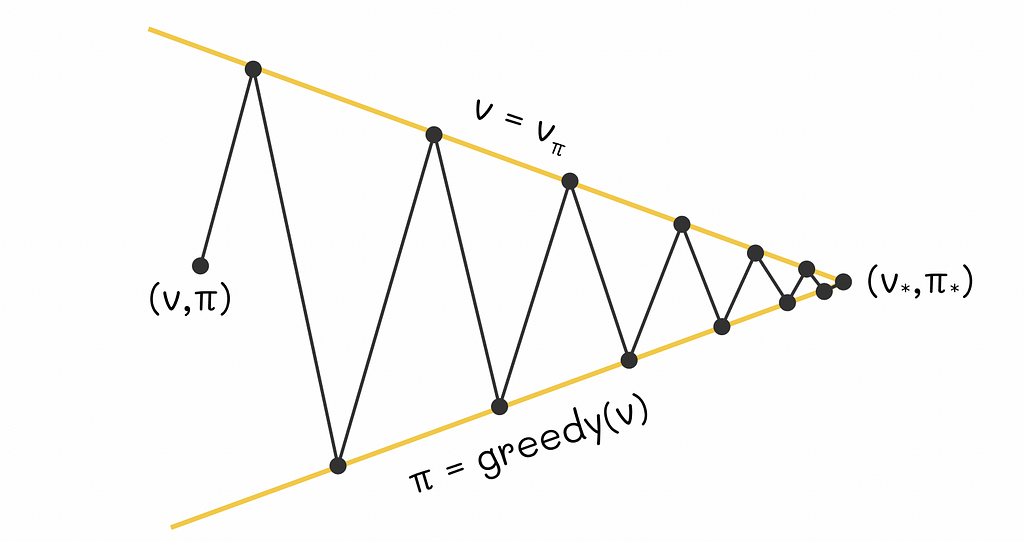
Every time when we calculate a greedy policy for the current V-function, we move closer to the policy line while moving away from the V-function line. That is logical because for the new computed policy, the previous V-function no longer applies. On the other hand, every time we perform policy evaluation, we move towards the projection of a point on the V-function line and thus we move further from the policy line: for the new estimated V-function, the current policy is no longer optimal. The whole process is repeated again.
As these two processes alternate between each other, both current V-function and policy gradually improve and at some moment in time they must reach a point of optimality that will represent an intersection between the V-function and policy lines.
In this article, we have gone through the main ideas behind policy evaluation and policy improvement. The beauty of these two algorithms is their ability to interact with each other to reach the optimal state. This approach only works in perfect environments where the agent’s probability transitions are given for all states and actions. Despite this constraint, many other reinforcement learning algorithms use the GPI method as a fundamental building block for finding optimal policies.
For environments with numerous states, several heuristics can be applied to accelerate the convergence speed one of which includes asynchronous updates during the policy evaluation step. Since the majority of reinforcement algorithms require a lot of computational resources, this technique becomes very useful and allows efficiently trading accuracy for gains in speed.
All images unless otherwise noted are by the author.
Reinforcement Learning, Part 2: Policy Evaluation and Improvement was originally published in Towards Data Science on Medium, where people are continuing the conversation by highlighting and responding to this story.
Originally appeared here:
Reinforcement Learning, Part 2: Policy Evaluation and Improvement
Go Here to Read this Fast! Reinforcement Learning, Part 2: Policy Evaluation and Improvement



Imagine streamlining your entire business management through a single, user-friendly interface on your phone. While juggling multiple apps is common practice, the future lies in consolidating all your interactions into one chat-based platform, powered by the capabilities of Large Language Models (LLMs).
For small businesses, this approach offers significant advantages. By centralizing data management tasks within a unified chat interface, owners can save time, reduce complexity, and minimize reliance on disparate software tools. The result is a more efficient allocation of resources, allowing a greater focus on core business growth activities.
However, the potential extends beyond just small businesses. The concepts and techniques detailed in this tutorial are adaptable to personal use cases as well. From managing to-do lists and tracking expenses to organizing collections, a chat-based interface provides an intuitive and efficient way to interact with your data.
This article is the second installment in a series that guides you through the process of developing such a software project, from initial concept to practical implementation. Building upon the components introduced in the previous article, we will establish the foundational elements of our application, including:
By the end of this tutorial, you will have a clear understanding of how to architect a chat-based interface that leverages LLMs to simplify data management tasks. Whether you’re a small business owner looking to streamline operations or an individual seeking to optimize personal organization, the principles covered here will provide a solid starting point for your own projects.
Let’s begin by briefly recapping the key takeaways from the previous article to set the context for our current objectives.
In the first part of this series, we built a prototype agent workflow capable of interacting with tool objects. Our goal was to reduce hallucination in tool arguments generated by the underlying language model, in our case gpt-3.5-turbo.
To achieve this, we implemented two key changes:
By setting all tool parameters to optional and manually checking for missing parameters, we eliminated the urge for the Agent/LLM to hallucinate missing values.
The key objects introduced in the previous article were:
These components formed the foundation of our agent system, allowing it to process user requests, select appropriate tools, and generate responses.
If you’d like a more detailed explanation or want to know the reasoning behind specific design choices, feel free to check out the previous article: Leverage OpenAI Tool Calling: Building a Reliable AI Agent from Scratch
With this recap in mind, let’s dive into the next phase of our project — integrating database functionality to store and manage business data.
Small businesses often face unique challenges when it comes to data maintenance. Like larger corporations, they need to regularly update and maintain various types of data, such as accounting records, time tracking, invoices, and more. However, the complexity and costs associated with modern ERP (Enterprise Resource Planning) systems can be prohibitive for small businesses. As a result, many resort to using a series of Excel spreadsheets to capture and maintain essential data.
The problem with this approach is that small business owners, who are rarely dedicated solely to administrative tasks, cannot afford to invest significant time and effort into complex administration and control processes. The key is to define lean processes and update data as it arises, minimizing the overhead of data management.
By leveraging the power of Large Language Models and creating a chat interface, we aim to simplify and streamline data management for small businesses. The chatbot will act as a unified interface, allowing users to input data, retrieve information, and perform various tasks using natural language commands. This eliminates the need for navigating multiple spreadsheets or developing complex web applications with multiple forms and dashboards.
Throughout this series, we will gradually enhance the chatbot’s capabilities, adding features such as role-based access control, advanced querying and evaluation, multimodal support, and integration with popular communication platforms like WhatsApp. By the end of the series, you will have a powerful and flexible tool that can adapt to your specific needs, whether you’re running a small business or simply looking to organize your personal life more efficiently.
Let’s get started!
To ensure a well-organized and maintainable project, we’ve structured our repository to encapsulate different functionalities and components systematically. Here’s an overview of the repository structure:
project-root/
│
├── database/
│ ├── db.py # Database connection and setup
│ ├── models.py # Database models/schemas
| └── utils.py # Database utilities
│
├── tools/
│ ├── base.py # Base class for tools
│ ├── add.py # Tool for adding data to the database
│ ├── query.py # Tool for querying data from the database
| └── utils.py # Tool utilities
│
├── agents/
│ ├── base.py # Main AI agent logic
│ ├── routing.py # Specialized agent for routing tasks
│ ├── task.py # Tool wrapper for OpenAI subagents
| └── utils.py # agent utilities
│
└── utils.py # Utility functions and classes
This structure allows for a clear separation of concerns, making it easier to develop, maintain, and scale our application.
Choosing the right database and ORM (Object-Relational Mapping) library is crucial for our application. For this project, we’ve selected the following frameworks:
By leveraging SQLModel, we can seamlessly integrate with Pydantic and SQLAlchemy, enabling efficient data validation and database operations while eliminating the risk of SQL injection attacks. Moreover, SQLModel allows us to easily build upon our previously designed Tool class, which uses Pydantic models for creating a tool schema.
To ensure the security and robustness of our application, we implement the following measures:
With our tech stack decided, let’s dive into setting up the database and defining our models.
To begin building our prototype application, we’ll define the essential database tables and their corresponding SQLModel definitions. For this tutorial, we’ll focus on three core tables:
These tables will serve as the foundation for our application, allowing us to demonstrate the key functionalities and interactions.
Create a new file named models.py in the database directory and define the tables using SQLModel:
# databasemodels.py
from typing import Optional
from pydantic import BeforeValidator, model_validator
from sqlmodel import SQLModel, Field
from datetime import time, datetime
from typing_extensions import Annotated
def validate_date(v):
if isinstance(v, datetime):
return v
for f in ["%Y-%m-%d", "%Y-%m-%d %H:%M:%S"]:
try:
return datetime.strptime(v, f)
except ValueError:
pass
raise ValueError("Invalid date format")
def numeric_validator(v):
if isinstance(v, int):
return float(v)
elif isinstance(v, float):
return v
raise ValueError("Value must be a number")
DateFormat = Annotated[datetime, BeforeValidator(validate_date)]
Numeric = Annotated[float, BeforeValidator(numeric_validator)]
class Customer(SQLModel, table=True):
id: Optional[int] = Field(primary_key=True, default=None)
company: str
first_name: str
last_name: str
phone: str
address: str
city: str
zip: str
country: str
class Revenue(SQLModel, table=True):
id: Optional[int] = Field(primary_key=True, default=None)
description: str
net_amount: Numeric
gross_amount: Numeric
tax_rate: Numeric
date: DateFormat
class Expense(SQLModel, table=True):
id: Optional[int] = Field(primary_key=True, default=None)
description: str
net_amount: Numeric = Field(description="The net amount of the expense")
gross_amount: Numeric
tax_rate: Numeric
date: DateFormat
In addition to the standard SQLModel fields, we’ve defined three custom type annotations: DateFormat, TimeFormat, and Numeric. These annotations leverage Pydantic’s BeforeValidator to ensure that the input data is correctly formatted before being stored in the database. The validate_date function handles the conversion of string input to the appropriate datetime. This approach allows us to accept a variety of date formats from the Large Language Model, reducing the need for strict format enforcement in the prompts.
With our models defined, we need a script to set up the database engine and create the corresponding tables. Let’s create a db.py file in the database directory to handle this:
# database/db.py
from database.models import *
from sqlmodel import SQLModel, create_engine
import os
# local stored database
DATABASE_URL = "sqlite:///app.db"
engine = create_engine(DATABASE_URL, echo=True)
def create_db_and_tables():
SQLModel.metadata.create_all(engine)
create_db_and_tables()
In this script, we import our models and the necessary SQLModel components. We define the DATABASE_URL to point to a local SQLite database file named app.db. We create an engine using create_engine from SQLModel, passing in the DATABASE_URL. The echo=True parameter enables verbose output for debugging purposes.
The create_db_and_tables function uses SQLModel.metadata.create_all to generate the corresponding tables in the database based on our defined models. Finally, we call this function to ensure the database and tables are created when the script is run.
With our database setup complete, we can now focus on updating our Tool class to work seamlessly with SQLModel and enhance our tool schema conversion process.
In this section, we’ll discuss the updates made to the Tool class to handle SQLModel instances and improve the validation process. For a more detailed explanation of the Tool class, visit my previous article.
First, we’ve added Type[SQLModel] as a possible type for the model field using the Union type hint. This allows the Tool class to accept both Pydantic’s BaseModel and SQLModel’s SQLModel as valid model types.
Next, we’ve introduced a new attribute called exclude_keys of type list[str] with a default value of [“id”]. The purpose of this attribute is to specify which keys should be excluded from the validation process and the OpenAI tool schema generation. In this case the default excluded key is id since for data entry creation with SqlModel the id is automatically generated during ingestion.
On top of that we introduced parse_model boolean attribute to our Tool class. Where we can basically decided if the tool function is called with our pydantic/SQLModel or with keyword arguments.
In the validate_input() method, we’ve added a check to ensure that the keys specified in exclude_keys are not considered as missing keys during the validation process. This is particularly useful for fields like id, which are automatically generated by SQLModel and should not be required in the input.
Similarly, in the openai_tool_schema property, we’ve added a loop to remove the excluded keys from the generated schema. This ensures that the excluded keys are not included in the schema sent to the OpenAI API. For recap we use the openai_tool_schema property to remove required arguments from our tool schema. This is done to elimenate hallucination by our language model.
Moreover, we changed the import from from pydantic.v1 import BaseModel to from pydantic import BaseModel. Since SQLModel is based on Pydantic v2, we want to be consistent and use Pydantic v2 at this point.
Here’s the updated code for the Tool class:
# tools/base.py
from typing import Type, Callable, Union
from tools.convert import convert_to_openai_tool
from pydantic import BaseModel, ConfigDict
from sqlmodel import SQLModel
class ToolResult(BaseModel):
content: str
success: bool
class Tool(BaseModel):
name: str
model: Union[Type[BaseModel], Type[SQLModel], None]
function: Callable
validate_missing: bool = True
parse_model: bool = False
exclude_keys: list[str] = ["id"]
model_config = ConfigDict(arbitrary_types_allowed=True)
def run(self, **kwargs) -> ToolResult:
if self.validate_missing and model is not None:
missing_values = self.validate_input(**kwargs)
if missing_values:
content = f"Missing values: {', '.join(missing_values)}"
return ToolResult(content=content, success=False)
if self.parse_model:
if hasattr(self.model, "model_validate"):
input_ = self.model.model_validate(kwargs)
else:
input_ = self.model(**kwargs)
result = self.function(input_)
else:
result = self.function(**kwargs)
return ToolResult(content=str(result), success=True)
def validate_input(self, **kwargs):
if not self.validate_missing or not self.model:
return []
model_keys = set(self.model.__annotations__.keys()) - set(self.exclude_keys)
input_keys = set(kwargs.keys())
missing_values = model_keys - input_keys
return list(missing_values)
@property
def openai_tool_schema(self):
schema = convert_to_openai_tool(self.model)
# set function name
schema["function"]["name"] = self.name
# remove required field
if schema["function"]["parameters"].get("required"):
del schema["function"]["parameters"]["required"]
# remove exclude keys
if self.exclude_keys:
for key in self.exclude_keys:
if key in schema["function"]["parameters"]["properties"]:
del schema["function"]["parameters"]["properties"][key]
return schema
These updates to the Tool class provide more flexibility and control over the validation process and schema generation when working with SQLModel instances.
In our Tool class, we create a schema from a Pydantic model using the convert_to_openai_tool function from Langchain. However, this function is based on Pydantic v1, while SQLModel uses Pydantic v2. To make the conversion function compatible, we need to adapt it. Let’s create a new script called convert.py:
# tools/convert.py
from langchain_core.utils.function_calling import _rm_titles
from typing import Type, Optional
from langchain_core.utils.json_schema import dereference_refs
from pydantic import BaseModel
def convert_to_openai_tool(
model: Type[BaseModel],
*,
name: Optional[str] = None,
description: Optional[str] = None,
) -> dict:
"""Converts a Pydantic model to a function description for the OpenAI API."""
function = convert_pydantic_to_openai_function(
model, name=name, description=description
)
return {"type": "function", "function": function}
def convert_pydantic_to_openai_function(
model: Type[BaseModel],
*,
name: Optional[str] = None,
description: Optional[str] = None,
rm_titles: bool = True,
) -> dict:
"""Converts a Pydantic model to a function description for the OpenAI API."""
model_schema = model.model_json_schema() if hasattr(model, "model_json_schema") else model.schema()
schema = dereference_refs(model_schema)
schema.pop("definitions", None)
title = schema.pop("title", "")
default_description = schema.pop("description", "")
return {
"name": name or title,
"description": description or default_description,
"parameters": _rm_titles(schema) if rm_titles else schema,
}
This adapted conversion function handles the differences between Pydantic v1 and v2, ensuring that our Tool class can generate compatible schemas for the OpenAI API.
Next, update the import statement in tools/base.py to use the new convert_to_openai_tool function:
# tools/base.py
from typing import Type, Callable, Union
from tools.convert import convert_to_openai_tool
from pydantic import BaseModel
from sqlmodel import SQLModel
#...rest of the code ...
With these changes in place, our Tool class can now handle SQLModel instances and generate schemas that are compatible with the OpenAI API.
Note: If you encounter dependency issues, you may consider removing the Langchain dependency entirely and including the _rm_titles and dereference_refs functions directly in the convert.py file.
By adapting the tool schema conversion process, we’ve ensured that our application can seamlessly work with SQLModel and Pydantic v2, enabling us to leverage the benefits of these libraries while maintaining compatibility with the OpenAI API.
In this section, we will create functions and tools to interact with our database tables using SQL.
First, let’s define a generic function add_row_to_table that takes a SQLModel instance and adds it to the corresponding table:
# tools/add.py
from sqlmodel import SQLModel, Session, select
def add_row_to_table(model_instance: SQLModel):
with Session(engine) as session:
session.add(model_instance)
session.commit()
session.refresh(model_instance)
return f"Successfully added {model_instance} to the table"
Next, we’ll create a model-specific function add_expense_to_table that takes input arguments for an Expense entry and adds it to the table:
# tools/add.py
# ...
def add_expense_to_table(**kwargs):
model_instance = Expense.model_validate(kwargs)
return add_row_to_table(model_instance)
In add_expense_to_table, we use the model_validate() method to trigger the execution of the previously defined BeforeValidator and ensure data validation.
To avoid writing separate functions for each table or SQLModel, we can dynamically generate the functions:
# example usage
def add_entry_to_table(sql_model: Type[SQLModel]):
# return a Callable that takes a SQLModel instance and adds it to the table
return lambda **data: add_row_to_table(model_instance=sql_model.model_validate(data))
add_expense_to_table = add_entry_to_table(Expense)
This approach produces the same result and can be used to dynamically generate functions for all other models.
With these functions in place, we can create tools using our Tool class to add entries to our database tables via the OpenAIAgent:
add_expense_tool = Tool(
name="add_expense_tool",
description="useful for adding expenses to database",
function=add_entry_to_table(Expense),
model=Expense,
validate_missing=True
)
add_revenue_tool = Tool(
name="add_revenue_tool",
description="useful for adding revenue to database",
function=add_entry_to_table(Revenue),
model=Revenue,
validate_missing=True
)
While we need to create an add_xxx_tool for each table due to varying input schemas, we only need one query tool for querying all tables. To eliminate the risk of SQL injection, we will use the SQL sanitization provided by SQLAlchemy and SQLModel. This means we will query the database through standard Python classes and objects instead of parsing SQL statements directly.
For the queries we want to perform on our tables, we will need the following logic:
In SQLModel, this corresponds to the following sanitized code when we want to find all expenses for coffee in the Expense table:
result = database.execute(
select(Expense).where(Expense.description == "Coffee")
)
To abstract this into a pydantic model:
# tools/query.py
from typing import Union, Literal
from pydantic import BaseModel
class WhereStatement(BaseModel):
column: str
operator: Literal["eq", "gt", "lt", "gte", "lte", "ne", "ct"]
value: str
class QueryConfig(BaseModel):
table_name: str
columns: list[str]
where: list[Union[WhereStatement, None]]
The QueryConfig model allows us to set a table_name, columns, and where statements. The where property accepts a list of WhereStatement models or an empty list (when we want to return all values with no further filtering). A WhereStatement is a submodel defining a column, operator, and value. The Literal type is used to restrict the allowed operators to a predefined set.
Next, we define a function that executes a query based on the QueryConfig:
# tools/query.py
# ...
from database.models import Expense, Revenue, Customer
TABLES = {
"expense": Expense,
"revenue": Revenue,
"customer": Customer
}
def query_data_function(**kwargs) -> ToolResult:
"""Query the database via natural language."""
query_config = QueryConfig.model_validate(kwargs)
if query_config.table_name not in TABLES:
return ToolResult(content=f"Table name {query_config.table_name} not found in database models", success=False)
sql_model = TABLES[query_config.table_name]
# query_config = validate_query_config(query_config, sql_model)
data = sql_query_from_config(query_config, sql_model)
return ToolResult(content=f"Query results: {data}", success=True)
def sql_query_from_config(
query_config: QueryConfig,
sql_model: Type[SQLModel]):
with Session(engine) as session:
selection = []
for column in query_config.select_columns:
if column not in sql_model.__annotations__:
return f"Column {column} not found in model {sql_model.__name__}"
selection.append(getattr(sql_model, column))
statement = select(*selection)
wheres = query_config.where
if wheres:
for where in wheres:
if where.column not in sql_model.__annotations__: # noqa
return (f"Column {where['column']} not found "
"in model {sql_model.__name__}")
elif where.operator == "eq":
statement = statement.where(
getattr(sql_model, where.column) == where.value)
elif where.operator == "gt":
statement = statement.where(
getattr(sql_model, where.column) > where.value)
elif where.operator == "lt":
statement = statement.where(
getattr(sql_model, where.column) < where.value)
elif where.operator == "gte":
statement = statement.where(
getattr(sql_model, where.column) >= where.value)
elif where.operator == "lte":
statement = statement.where(
getattr(sql_model, where.column) <= where.value)
elif where.operator == "ne":
statement = statement.where(
getattr(sql_model, where.column) != where.value)
elif where.operator == "ct":
statement = statement.where(
getattr(sql_model, where.column).contains(where.value))
result = session.exec(statement)
data = result.all()
try:
data = [repr(d) for d in data]
except:
pass
return data
The query_data_function serves as a high-level abstraction for selecting our table model from the TABLES dictionary, while sql_query_from_config is the underlying function for executing the QueryConfig on a table (SQLModel).
In `QueryConfig` you can choose to also define table_names as Literal type, where you hard code the available table names into it. You can even dynamically define the Literal using our TABLES dictionary. By doing so you can reduce false arguments for table_name. For now I have choosen to not use an enum object, because I will provide the agent prompt with context about the currently available tables and there underling ORM schema. I plan to add a tool for our future agent to create new tables on it’s own.While I can dynamically change the agent’s prompt, it won’t be straightforward to change the enum object within `QueryConfig` on our running server.
Finally, we can define our query tool:
query_data_tool = Tool(
name="query_data_tool",
description = "useful to perform queries on a database table",
model=QueryConfig,
function=query_data_function,
)
With these tools in place, our OpenAIAgent is now capable of adding and querying data in our database tables using natural language commands.
To enable successful tool usage for our previously defined tools, the Agent from the previous article will need more context information, especially for using the query tool. The Agent prompt will need to include information about available tables and their schemas. Since we only use two tables at this point, we can include the ORM schema and table names in the system prompt or user prompt. Both options might work well, but I prefer to include variable information like this in the user prompt. By doing so, we can create few-shot examples that demonstrate context-aware tool usage.
To make our Agent capable of handling variable context in the system prompt and user prompt, we can update our Agent class as follows:
import colorama
from colorama import Fore
from openai import OpenAI
from pydantic import BaseModel
from tools.base import Tool, ToolResult
from agents.utils import parse_function_args, run_tool_from_response
class StepResult(BaseModel):
event: str
content: str
success: bool
SYSTEM_MESSAGE = """You are tasked with completing specific objectives and must report the outcomes. At your disposal, you have a variety of tools, each specialized in performing a distinct type of task.
For successful task completion:
Thought: Consider the task at hand and determine which tool is best suited based on its capabilities and the nature of the work. If you can complete the task or answer a question, soley by the information provided you can use the report_tool directly.
Use the report_tool with an instruction detailing the results of your work or to answer a user question.
If you encounter an issue and cannot complete the task:
Use the report_tool to communicate the challenge or reason for the task's incompletion.
You will receive feedback based on the outcomes of each tool's task execution or explanations for any tasks that couldn't be completed. This feedback loop is crucial for addressing and resolving any issues by strategically deploying the available tools.
Return only one tool call at a time.
{context}
"""
class OpenAIAgent:
def __init__(
self,
tools: list[Tool],
client: OpenAI = OpenAI(),
system_message: str = SYSTEM_MESSAGE,
model_name: str = "gpt-3.5-turbo-0125",
max_steps: int = 5,
verbose: bool = True,
examples: list[dict] = None,
context: str = None,
user_context: str = None
):
self.tools = tools
self.client = client
self.model_name = model_name
self.system_message = system_message
self.step_history = []
self.max_steps = max_steps
self.verbose = verbose
self.examples = examples or []
self.context = context or ""
self.user_context = user_context
def to_console(self, tag: str, message: str, color: str = "green"):
if self.verbose:
color_prefix = Fore.__dict__[color.upper()]
print(color_prefix + f"{tag}: {message}{colorama.Style.RESET_ALL}")
def run(self, user_input: str, context: str = None):
openai_tools = [tool.openai_tool_schema for tool in self.tools]
system_message = self.system_message.format(context=context)
if self.user_context:
context = f"{self.user_context}n{context}" if context else self.user_context
if context:
user_input = f"{context}n---nnUser Message: {user_input}"
self.to_console("START", f"Starting Agent with Input:n'''{user_input}'''")
self.step_history = [
{"role": "system", "content": system_message},
*self.examples,
{"role": "user", "content": user_input}
]
step_result = None
i = 0
while i < self.max_steps:
step_result = self.run_step(self.step_history, openai_tools)
if step_result.event == "finish":
break
elif step_result.event == "error":
self.to_console(step_result.event, step_result.content, "red")
else:
self.to_console(step_result.event, step_result.content, "yellow")
i += 1
self.to_console("Final Result", step_result.content, "green")
return step_result.content
def run_step(self, messages: list[dict], tools):
# plan the next step
response = self.client.chat.completions.create(
model=self.model_name,
messages=messages,
tools=tools
)
# check for multiple tool calls
if response.choices[0].message.tool_calls and len(response.choices[0].message.tool_calls) > 1:
messages = [
*self.step_history,
{"role": "user", "content": "Error: Please return only one tool call at a time."}
]
return self.run_step(messages, tools)
# add message to history
self.step_history.append(response.choices[0].message)
# check if tool call is present
if not response.choices[0].message.tool_calls:
msg = response.choices[0].message.content
step_result = StepResult(event="Error", content=f"No tool calls were returned.nMessage: {msg}", success=False)
return step_result
tool_name = response.choices[0].message.tool_calls[0].function.name
tool_kwargs = parse_function_args(response)
# execute the tool call
self.to_console("Tool Call", f"Name: {tool_name}nArgs: {tool_kwargs}", "magenta")
tool_result = run_tool_from_response(response, tools=self.tools)
tool_result_msg = self.tool_call_message(response, tool_result)
self.step_history.append(tool_result_msg)
if tool_name == "report_tool":
try:
step_result = StepResult(
event="finish",
content=tool_result.content,
success=True
)
except:
print(tool_result)
raise ValueError("Report Tool failed to run.")
return step_result
elif tool_result.success:
step_result = StepResult(
event="tool_result",
content=tool_result.content,
success=True)
else:
step_result = StepResult(
event="error",
content=tool_result.content,
success=False
)
return step_result
def tool_call_message(self, response, tool_result: ToolResult):
tool_call = response.choices[0].message.tool_calls[0]
return {
"tool_call_id": tool_call.id,
"role": "tool",
"name": tool_call.function.name,
"content": tool_result.content,
}
The main changes compared to our previous version:
Now we can define a system context and a user context while initializing our agent. Additionally, we can pass a user context when calling the run method. If context is passed to the run method, it will overwrite the user_context from initialization for that run.
Before we can run our Agent, let’s define a function that generates context information. We want to automatically generate user_context, which we can then pass to the Agent’s run function as implemented above. To keep it simple, we want a single line for each table as context information that should include:
After a few attempts with trial and error, the following function will do the job:
# utils.py
from typing import Type
import types
import typing
import sqlalchemy
from pydantic import BaseModel
def orm_model_to_string(input_model_cls: Type[BaseModel]):
"""Get the ORM model string from the input model"""
def process_field(key, value):
if key.startswith("__"):
return None
if isinstance(value, typing._GenericAlias):
if value.__origin__ == sqlalchemy.orm.base.Mapped:
return None
if isinstance(value, typing._AnnotatedAlias): # noqa
return key, value.__origin__
elif isinstance(value, typing._UnionGenericAlias) or isinstance(value, types.UnionType):
return key, value.__args__[0]
return key, value
fields = dict(filter(None, (process_field(k, v) for k, v in input_model_cls.__annotations__.items())))
return ", ".join([f"{k} = <{v.__name__}>" for k, v in fields.items()])
def generate_context(*table_models) -> str:
context_str = "You can access the following tables in database:n"
for table in table_models:
context_str += f" - {table.__name__}: {orm_model_to_string(table)}n"
return context_str
If we pass Expense and Revenue to generate_context(), we should get the following context string:
We want the Agent to know the current date and day of the week, so we can reference the correct date. So let’s add some date parsing functions to our utils class:
# utils.py
from datetime import datetime
#... rest of utils.py ...
def weekday_by_date(date: datetime):
days = ["Monday", "Tuesday", "Wednesday", "Thursday", "Friday", "Saturday", "Sunday"]
return days[date.weekday()]
def date_to_string(date: datetime):
return f"{weekday_by_date(date)} {parse_date(date)}"
def parse_date(date: datetime):
return date.strftime("%Y-%m-%d")
Now let’s create the context for a query agent
# utils.py
# ...
def generate_query_context(*table_models) -> str:
today = f"Today is {date_to_string(datetime.now())}"
context_str = "You can access the following tables in database:n"
for table in table_models:
context_str += f" - {table.__name__}: {orm_model_to_string(table)}n"
return f"{today}n{context_str}"
from database.models import Expense, Revenue
print(generate_query_context(Expense, Revenue))
Today is Sunday 2024-04-21
You can access the following tables in database:
- Expense: id = <int>, description = <str>, net_amount = <float>, gross_amount = <float>, tax_rate = <float>, date = <datetime>
- Revenue: id = <int>, description = <str>, net_amount = <float>, gross_amount = <float>, tax_rate = <float>, date = <datetime>
As we add more tools, the complexity of our setup may start to limit the usability of cheaper models like “gpt-3.5-turbo”. In the next article, we might consider switching to Anthropic Claude, since their newly released tool-use API feature seems promising, even for the more affordable HAIKU model, in handling multiple tools simultaneously. However, for now, we will continue using OpenAI’s GPT models.
When developing for personal use and before creating production-ready applications, I find it useful to optimize the workflow for smaller models, such as gpt-3.5-turbo in this case. This approach forces us to create a streamlined processing logic and prompting system. While we may not achieve 100% reliability without using the most powerful model, we will be able to catch flaws and identify unclear instructions. If your application works in 9 out of 10 cases with a smaller model, you will have a production-ready logic that will perform even better with a stronger model.
To make multi-tool handling reliable with gpt-3.5-turbo we will implement a routing agent whose sole purpose is to route the user query to the appropriate task agent. This allows us to separate execution logic and reduce complexity. Each agent will have a limited scope, enabling us to separate access roles and operations in the future. I have observed that even with gpt-4, there are instances where the agent does not know when its task is finished.
By introducing a routing agent, we can break down the problem into smaller, more manageable parts. The routing agent will be responsible for understanding the user’s intent and directing the query to the relevant task agent. This approach not only simplifies the individual agents’ responsibilities but also makes the system more modular and easier to maintain.
Furthermore, separating the execution logic and complexity will pave the way for implementing role-based access control in the future. Each task agent can be assigned specific permissions and access levels, ensuring that sensitive operations are only performed by authorized agents.
While the routing agent adds an extra step in the process, it ultimately leads to a more robust and scalable system. By optimizing for smaller models and focusing on clear, concise prompts, we can create a solid foundation that will perform even better when we switch to more powerful models like Claude Opus or GPT-4.
Let’s have a look on the implementation of the routing agent
# agents/routing.py
from openai import OpenAI
import colorama
from agents.task_agent import TaskAgent
from agents.utils import parse_function_args
SYSTEM_MESSAGE = """You are a helpful assistant.
Role: You are an AI Assistant designed to serve as the primary point of contact for users interacting through a chat interface.
Your primary role is to understand users' requests related to database operations and route these requests to the appropriate tool.
Capabilities:
You have access to a variety of tools designed for Create, Read operations on a set of predefined tables in a database.
Tables:
{table_names}
"""
NOTES = """Important Notes:
Always confirm the completion of the requested operation with the user.
Maintain user privacy and data security throughout the interaction.
If a request is ambiguous or lacks specific details, ask follow-up questions to clarify the user's needs."""
class RoutingAgent:
def __init__(
self,
tools: list[TaskAgent] = None,
client: OpenAI = OpenAI(),
system_message: str = SYSTEM_MESSAGE,
model_name: str = "gpt-3.5-turbo-0125",
max_steps: int = 5,
verbose: bool = True,
prompt_extra: dict = None,
examples: list[dict] = None,
context: str = None
):
self.tools = tools or ROUTING_AGENTS
self.client = client
self.model_name = model_name
self.system_message = system_message
self.memory = []
self.step_history = []
self.max_steps = max_steps
self.verbose = verbose
self.prompt_extra = prompt_extra or PROMPT_EXTRA
self.examples = self.load_examples(examples)
self.context = context or ""
def load_examples(self, examples: list[dict] = None):
examples = examples or []
for agent in self.tools:
examples.extend(agent.routing_example)
return examples
def run(self, user_input: str, employee_id: int = None, **kwargs):
context = create_routing_agent_context(employee_id)
if context:
user_input_with_context = f"{context}n---nnUser Message: {user_input}"
else:
user_input_with_context = user_input
self.to_console("START", f"Starting Task Agent with Input:n'''{user_input_with_context}'''")
partial_variables = {**self.prompt_extra, "context": context}
system_message = self.system_message.format(**partial_variables)
messages = [
{"role": "system", "content": system_message},
*self.examples,
{"role": "user", "content": user_input}
]
tools = [tool.openai_tool_schema for tool in self.tools]
response = self.client.chat.completions.create(
model=self.model_name,
messages=messages,
tools=tools
)
self.step_history.append(response.choices[0].message)
self.to_console("RESPONSE", response.choices[0].message.content, color="blue")
tool_kwargs = parse_function_args(response)
tool_name = response.choices[0].message.tool_calls[0].function.name
self.to_console("Tool Name", tool_name)
self.to_console("Tool Args", tool_kwargs)
agent = self.prepare_agent(tool_name, tool_kwargs)
return agent.run(user_input)
def prepare_agent(self, tool_name, tool_kwargs):
for agent in self.tools:
if agent.name == tool_name:
input_kwargs = agent.arg_model.model_validate(tool_kwargs)
return agent.load_agent(**input_kwargs.dict())
raise ValueError(f"Agent {tool_name} not found")
def to_console(self, tag: str, message: str, color: str = "green"):
if self.verbose:
color_prefix = colorama.Fore.__dict__[color.upper()]
print(color_prefix + f"{tag}: {message}{colorama.Style.RESET_ALL}")
The biggest differences to our OpenAIAgent are:
To use our OpenAIAgentas a tool, we need to introduce some sort of tool class dedicated for Agents. We want to define a name and description for each agent and automate the initialization process. Therefore, we define our last class for this tutorial theTaskAgent.
The TaskAgent class serves similar functionality as the Tool class. We define a name a description and an input model which we call arg_model.
from typing import Type, Callable, Optional
from agents.base import OpenAIAgent
from tools.base import Tool
from tools.report_tool import report_tool
from pydantic import BaseModel, ConfigDict, Field
from tools.utils import convert_to_openai_tool
SYSTEM_MESSAGE = """You are tasked with completing specific objectives and must report the outcomes. At your disposal, you have a variety of tools, each specialized in performing a distinct type of task.
For successful task completion:
Thought: Consider the task at hand and determine which tool is best suited based on its capabilities and the nature of the work.
If you can complete the task or answer a question, soley by the information provided you can use the report_tool directly.
Use the report_tool with an instruction detailing the results of your work or to answer a user question.
If you encounter an issue and cannot complete the task:
Use the report_tool to communicate the challenge or reason for the task's incompletion.
You will receive feedback based on the outcomes of each tool's task execution or explanations for any tasks that couldn't be completed. This feedback loop is crucial for addressing and resolving any issues by strategically deploying the available tools.
On error: If information are missing consider if you can deduce or calculate the missing information and repeat the tool call with more arguments.
Use the information provided by the user to deduct the correct tool arguments.
Before using a tool think about the arguments and explain each input argument used in the tool.
Return only one tool call at a time! Explain your thoughts!
{context}
"""
class EmptyArgModel(BaseModel):
pass
class TaskAgent(BaseModel):
name: str
description: str
arg_model: Type[BaseModel] = EmptyArgModel
create_context: Callable = None
create_user_context: Callable = None
tool_loader: Callable = None
system_message: str = SYSTEM_MESSAGE
tools: list[Tool]
examples: list[dict] = None
routing_example: list[dict] = Field(default_factory=list)
model_config = ConfigDict(arbitrary_types_allowed=True)
def load_agent(self, **kwargs) -> OpenAIAgent:
input_kwargs = self.arg_model(**kwargs)
kwargs = input_kwargs.dict()
context = self.create_context(**kwargs) if self.create_context else None
user_context = self.create_user_context(**kwargs) if self.create_user_context else None
if self.tool_loader:
self.tools.extend(self.tool_loader(**kwargs))
if report_tool not in self.tools:
self.tools.append(report_tool)
return OpenAIAgent(
tools=self.tools,
context=context,
user_context=user_context,
system_message=self.system_message,
examples=self.examples,
)
@property
def openai_tool_schema(self):
return convert_to_openai_tool(self.arg_model, name=self.name, description=self.description)
Additionally, we added all relevant attributes to our TaskAgent class, which we need for an underlying specialized OpenAIAgent :
Moreover, we have an emty BaseModel called EmptyArgModel which is default arg_model in our TaskAgent
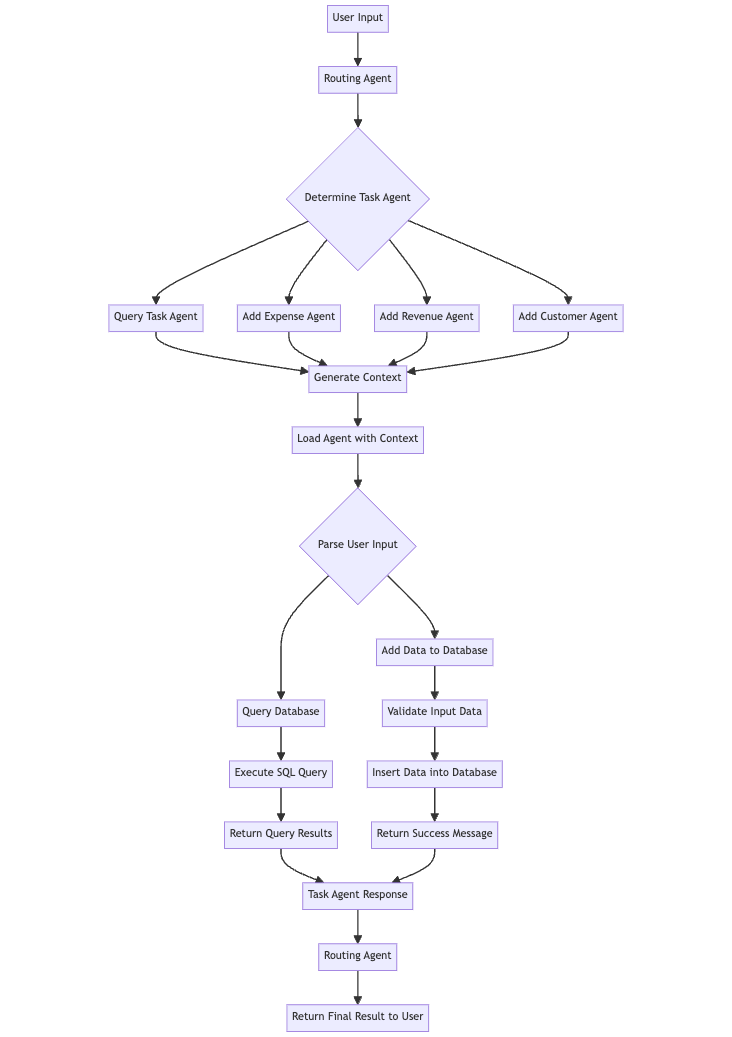
Let’s see if it all plays together!
Now, it’s time to test if our routing and subagents work well together. As we introduced examples as a paremeter we can use several test runs to inspect major flaws in the execution and define example usage for each sub agent.
Let’s define our subagents first:
from database.models import Expense, Revenue, Customer
from agents.task import TaskAgent
from utils import generate_query_context
from tools.base import Tool
from tools.query import query_data_tool
from tools.add import add_entry_to_table
query_task_agent = TaskAgent(
name="query_agent",
description="An agent that can perform queries on multiple data sources",
create_user_context=lambda: generate_query_context(Expense, Revenue, Customer),
tools=[query_data_tool]
)
add_expense_agent = TaskAgent(
name="add_expense_agent",
description="An agent that can add an expense to the database",
create_user_context=lambda: generate_query_context(Expense) + "nRemarks: The tax rate is 0.19. The user provide the net amount you need to calculate the gross amount.",
tools=[
Tool(
name="add_expense",
description="Add an expense to the database",
function=add_entry_to_table(Expense),
model=Expense
)
]
)
add_revenue_agent = TaskAgent(
name="add_revenue_agent",
description="An agent that can add a revenue entry to the database",
create_user_context=lambda: generate_query_context(Revenue) + "nRemarks: The tax rate is 0.19. The user provide the gross_amount you should use the tax rate to calculate the net_amount.",
tools=[
Tool(
name="add_revenue",
description="Add a revenue entry to the database",
function=add_entry_to_table(Revenue),
model=Revenue
)
]
)
add_customer_agent = TaskAgent(
name="add_customer_agent",
description="An agent that can add a customer to the database",
create_user_context=lambda: generate_query_context(Customer),
tools=[
Tool(
name="add_customer",
description="Add a customer to the database",
function=add_entry_to_table(Customer),
model=Customer
)
]
)
As you can see we added some remarks as string to create_user_context for revenue and expense agents. We want the sub agent to handle tax rates and calculate the net or gross amount automatically to test the reasoning capabilites of our sub agent.
from agents.routing import RoutingAgent
routing_agent = RoutingAgent(
tools=[
query_task_agent,
add_expense_agent,
add_revenue_agent,
add_customer_agent
]
)
routing_agent.run("I have spent 5 € on a office stuff. Last Thursday")
START: Starting Routing Agent with Input:
I have spent 5 € on a office stuff. Last Thursday
Tool Name: add_expense_agent
Tool Args: {}
START: Starting Task Agent with Input:
"""Today is Sunday 2024-04-21
You can access the following tables in database:
- expense: id = <int>, description = <str>, net_amount = <float>, gross_amount = <float>, tax_rate = <float>, date = <datetime>
Remarks: The tax rate is 0.19. The user provide the net amount you need to calculate the gross amount.
---
User Message: I have spent 5 € on a office stuff. Last Thursday"""
Tool Call: Name: add_expense
Args: {'description': 'office stuff', 'net_amount': 5, 'tax_rate': 0.19, 'date': '2024-04-18'}
Message: None
error: Missing values: gross_amount
Tool Call: Name: add_expense
Args: {'description': 'office stuff', 'net_amount': 5, 'tax_rate': 0.19, 'date': '2024-04-18', 'gross_amount': 5.95}
Message: None
tool_result: Successfully added net_amount=5.0 id=2 gross_amount=5.95 description='office stuff' date=datetime.datetime(2024, 4, 18, 0, 0) tax_rate=0.19 to the table
Error: No tool calls were returned.
Message: I have successfully added the expense for office stuff with a net amount of 5€, calculated the gross amount, and recorded it in the database.
Tool Call: Name: report_tool
Args: {'report': 'Expense for office stuff with a net amount of 5€ has been successfully added. Gross amount calculated as 5.95€.'}
Message: None
Final Result: Expense for office stuff with a net amount of 5€ has been successfully added. Gross amount calculated as 5.95€.
Now let’s add a revenue:
routing_agent.run("Two weeks ago on Saturday we had a revenue of 1000 € in the shop")
START: Starting Routing Agent with Input:
Two weeks ago on Saturday we had a revenue of 1000 € in the shop
Tool Name: add_revenue_agent
Tool Args: {}
START: Starting Task Agent with Input:
"""Today is Sunday 2024-04-21
You can access the following tables in database:
- revenue: id = <int>, description = <str>, net_amount = <float>, gross_amount = <float>, tax_rate = <float>, date = <datetime>
Remarks: The tax rate is 0.19. The user provide the gross_amount you should use the tax rate to calculate the net_amount.
---
User Message: Two weeks ago on Saturday we had a revenue of 1000 € in the shop"""
Tool Call: Name: add_revenue
Args: {'description': 'Revenue from the shop', 'gross_amount': 1000, 'tax_rate': 0.19, 'date': '2024-04-06'}
Message: None
error: Missing values: net_amount
Tool Call: Name: add_revenue
Args: {'description': 'Revenue from the shop', 'gross_amount': 1000, 'tax_rate': 0.19, 'date': '2024-04-06', 'net_amount': 840.34}
Message: None
tool_result: Successfully added net_amount=840.34 gross_amount=1000.0 tax_rate=0.19 description='Revenue from the shop' id=1 date=datetime.datetime(2024, 4, 6, 0, 0) to the table
Error: No tool calls were returned.
Message: The revenue entry for the shop on April 6, 2024, with a gross amount of 1000€ has been successfully added to the database. The calculated net amount after applying the tax rate is 840.34€.
Tool Call: Name: report_tool
Args: {'report': 'completed'}
Message: None
Final Result: completed
And for the last test let’s try to query the revenue that created from database:
routing_agent.run("How much revenue did we made this month?")
START: Starting Routing Agent with Input:
How much revenue did we made this month?
Tool Name: query_agent
Tool Args: {}
START: Starting Agent with Input:
"""Today is Sunday 2024-04-21
You can access the following tables in database:
- expense: id = <int>, description = <str>, net_amount = <float>, gross_amount = <float>, tax_rate = <float>, date = <datetime>
- revenue: id = <int>, description = <str>, net_amount = <float>, gross_amount = <float>, tax_rate = <float>, date = <datetime>
- customer: id = <int>, company_name = <str>, first_name = <str>, last_name = <str>, phone = <str>, address = <str>, city = <str>, zip = <str>, country = <str>
---
User Message: How much revenue did we made this month?"""
Tool Call: Name: query_data_tool
Args: {'table_name': 'revenue', 'select_columns': ['gross_amount'], 'where': [{'column': 'date', 'operator': 'gte', 'value': '2024-04-01'}, {'column': 'date', 'operator': 'lte', 'value': '2024-04-30'}]}
Message: None
tool_result: content="Query results: ['1000.0']" success=True
Error: No tool calls were returned.
Message: The revenue made this month is $1000.00.
Tool Call: Name: report_tool
Args: {'report': 'The revenue made this month is $1000.00.'}
Message: None
Final Result: The revenue made this month is $1000.00.
All tools worked as expected. The Routing Agent worked perfectly. For theTask Agent I had to update the prompt several times.
I would recommend to add some example tool calls to each task agent when not working with state-of-the-art models like gpt-4. In general I would recommend to tackle flaws with examples and more intuitive designs instead of prompt engineering. Reapting flaws are indicators for not straightforward designs. For example when the agent struggles with calculating the gross or net amount just add a ‘calculate_gross_amount_tool’ or ‘calculate_net_amount_tool’. GPT-4 on the other hand would handle use cases like that without hestitating.
In this article, we’ve taken a significant step forward in our journey to create a comprehensive chat-based interface for managing small businesses using Large Language Models.
By setting up our database schema, defining core functionalities, and structuring our project repository, we’ve laid a solid foundation for the development of our application.
We started by designing our database models using SQLModel, which allowed us to seamlessly integrate with Pydantic and SQLAlchemy. This approach ensures efficient data validation and database operations while minimizing the risk of SQL injection attacks.
We then proceeded to update our Tool class to handle SQLModel instances and improve the validation process. Next, we implemented SQL tools for adding data to our database tables and querying data using natural language commands. By leveraging the power of SQLModel and Pydantic, we were able to create a robust and flexible system that can handle a wide range of user inputs and generate accurate SQL queries.
We configured our OpenAIAgent to provide context-aware tool usage by updating the agent class to handle variable context in the system prompt and user prompt. This allows our agent to understand the available tables and their schemas, enabling more accurate and efficient tool usage. While we’ve made significant progress, there’s still much more to explore and implement.
To further enhance our chatbot, we introduced the TaskAgent class, which serves a similar functionality as the Tool class. The TaskAgent allows us to define a name, description, and input model for each agent, automating the initialization process.
Finally, we tested our routing and subagents by defining subagents for querying data, adding expenses, adding revenue. We demonstrated how the agents handle tax rates and calculate net or gross amounts automatically, showcasing the reasoning capabilities of our subagents.
In the next part of this series, we’ll focus on enhancing our agent’s capabilities by adding support for more tools and potentially testing Claude as a new default language model. We’ll also explore integrating our application with popular communication platforms (WhatsApp) to make it even more accessible and user-friendly.
As we continue to refine and expand our application, the possibilities are endless. By leveraging the power of Large Language Models and creating intuitive chat-based interfaces, we can revolutionize the way small businesses manage their data and streamline their operations. Stay tuned for the next installment in this exciting series!
Additionally, the entire source code for the projects covered is available on GitHub. You can access it at https://github.com/elokus/ArticleParte2.
Building an AI-Powered Business Manager was originally published in Towards Data Science on Medium, where people are continuing the conversation by highlighting and responding to this story.
Originally appeared here:
Building an AI-Powered Business Manager
Go Here to Read this Fast! Building an AI-Powered Business Manager